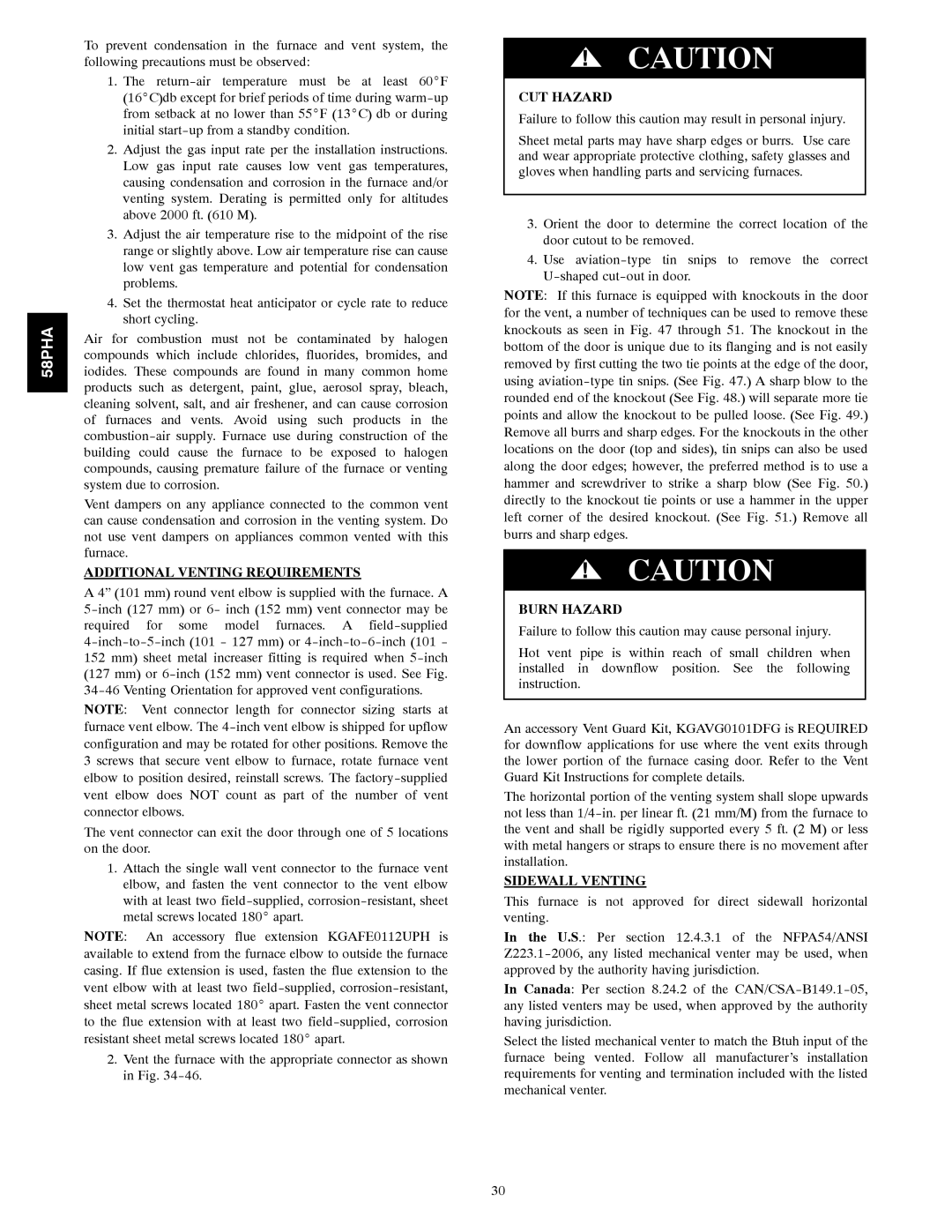
58PHA
To prevent condensation in the furnace and vent system, the following precautions must be observed:
1.The
2.Adjust the gas input rate per the installation instructions. Low gas input rate causes low vent gas temperatures, causing condensation and corrosion in the furnace and/or venting system. Derating is permitted only for altitudes above 2000 ft. (610 M).
3.Adjust the air temperature rise to the midpoint of the rise range or slightly above. Low air temperature rise can cause low vent gas temperature and potential for condensation problems.
4.Set the thermostat heat anticipator or cycle rate to reduce short cycling.
Air for combustion must not be contaminated by halogen compounds which include chlorides, fluorides, bromides, and iodides. These compounds are found in many common home products such as detergent, paint, glue, aerosol spray, bleach, cleaning solvent, salt, and air freshener, and can cause corrosion of furnaces and vents. Avoid using such products in the
Vent dampers on any appliance connected to the common vent can cause condensation and corrosion in the venting system. Do not use vent dampers on appliances common vented with this furnace.
ADDITIONAL VENTING REQUIREMENTS
A 4” (101 mm) round vent elbow is supplied with the furnace. A
152mm) sheet metal increaser fitting is required when
(127 mm) or
3screws that secure vent elbow to furnace, rotate furnace vent elbow to position desired, reinstall screws. The
The vent connector can exit the door through one of 5 locations on the door.
1.Attach the single wall vent connector to the furnace vent elbow, and fasten the vent connector to the vent elbow with at least two
NOTE: An accessory flue extension KGAFE0112UPH is available to extend from the furnace elbow to outside the furnace casing. If flue extension is used, fasten the flue extension to the vent elbow with at least two
2.Vent the furnace with the appropriate connector as shown in Fig.
!CAUTION
CUT HAZARD
Failure to follow this caution may result in personal injury.
Sheet metal parts may have sharp edges or burrs. Use care and wear appropriate protective clothing, safety glasses and gloves when handling parts and servicing furnaces.
3.Orient the door to determine the correct location of the door cutout to be removed.
4.Use
NOTE: If this furnace is equipped with knockouts in the door for the vent, a number of techniques can be used to remove these knockouts as seen in Fig. 47 through 51. The knockout in the bottom of the door is unique due to its flanging and is not easily removed by first cutting the two tie points at the edge of the door, using
!CAUTION
BURN HAZARD
Failure to follow this caution may cause personal injury.
Hot vent pipe is within reach of small children when installed in downflow position. See the following instruction.
An accessory Vent Guard Kit, KGAVG0101DFG is REQUIRED for downflow applications for use where the vent exits through the lower portion of the furnace casing door. Refer to the Vent Guard Kit Instructions for complete details.
The horizontal portion of the venting system shall slope upwards not less than
SIDEWALL VENTING
This furnace is not approved for direct sidewall horizontal venting.
In the U.S.: Per section 12.4.3.1 of the NFPA54/ANSI
In Canada: Per section 8.24.2 of the
Select the listed mechanical venter to match the Btuh input of the furnace being vented. Follow all manufacturer’s installation requirements for venting and termination included with the listed mechanical venter.
30
